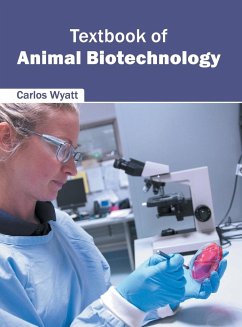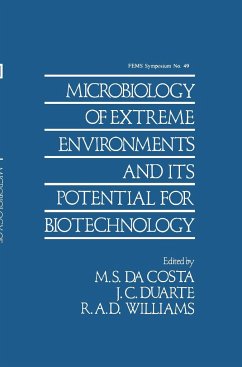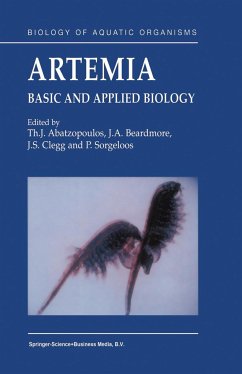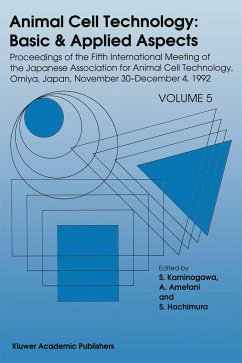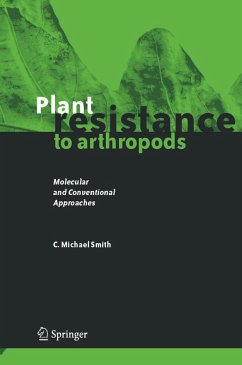
Molecular Biology and Biotechnology of Extremophiles
Versandkostenfrei!
Versandfertig in 6-10 Tagen
229,99 €
inkl. MwSt.

PAYBACK Punkte
115 °P sammeln!
1 Biochemistry and molecular biology of the extremely thermophilic archaeobacteria.- 1.1 Introduction.- 1.2 Archaeobacterial phylogeny.- 1.3 Ecology of the thermophilic Archaea.- 1.3.1 Morphology of the Archaea.- 1.3.2 Physiology and biochemistry of the Archea.- 1.3.3 Enzymes.- 1.3.4 Structural macromolecules.- 1.3.5 Lipids and lipid biosynthesis.- 1.3.6 Molecular genetics of the extremely thermophilic Archaea.- References.- 2 The molecular genetics and biotechnological application of enzymes from extremely thermophilic eubacteria.- 2.1 Introduction.- 2.2 Aerobic eubacteria.- 2.2.1 The molecul...
1 Biochemistry and molecular biology of the extremely thermophilic archaeobacteria.- 1.1 Introduction.- 1.2 Archaeobacterial phylogeny.- 1.3 Ecology of the thermophilic Archaea.- 1.3.1 Morphology of the Archaea.- 1.3.2 Physiology and biochemistry of the Archea.- 1.3.3 Enzymes.- 1.3.4 Structural macromolecules.- 1.3.5 Lipids and lipid biosynthesis.- 1.3.6 Molecular genetics of the extremely thermophilic Archaea.- References.- 2 The molecular genetics and biotechnological application of enzymes from extremely thermophilic eubacteria.- 2.1 Introduction.- 2.2 Aerobic eubacteria.- 2.2.1 The molecular biology and genetics of Thermus.- 2.2.2 Thermus aquaticus DNA polymerase.- 2.2.3 Thermus aquaticus restriction-modification system.- 2.2.4 Expression of other genes from Thermus genomic libraries.- 2.2.5 Proteinases from Thermus spp.- 2.2.6 Genetic transfer and plasmids in Thermus.- 2.2.7 A repetitive sequence in Thermus thermophilus.- 2.2.8 Promoter regions and other control sequences in Thermus.- 2.2.9 Genes and proteins from thermophilic strains of Bacillus.- 2.2.10 ?-Amylases from Bacillus spp.- 2.2.11 Pullulanases and related enzymes from thermophilic bacilli.- 2.2.12 Other genes and genetic systems in Bacillus stearothermophilus.- 2.3 Anaerobic eubacteria.- 2.3.1 Cloning of genes involved in cellulose hydrolysis.- 2.3.2 Hemicellulose hydrolysis.- 2.3.3 Starch hydrolysis.- 2.3.4 Pullulanases.- 2.4 Other enzymes from anaerobic thermophiles.- 2.4.1 Thermotoga.- References.- 3 Biotechnological prospects for halophiles and halotolerant micro-organisms.- 3.1 Introduction.- 3.2 Micro-organisms in the food industry.- 3.2.1 Food spoilage.- 3.2.2 Fermentation products.- 3.2.3 Single-cell protein (SCP).- 3.2.4 Food colouring/flavouring.- 3.3 Production of commercially useful compounds.- 3.3.1 Biological fermentation processes at high salinities.- 3.3.2 Pharmaceutical compounds.- 3,3.3 Polymers.- 3.3.4 Enzymes.- 3.3.5 Compatible solutes.- 3.4 Future aspects.- 3.4.1 Environmental biotechnology.- 3.4.2 Agricultural aspects.- 3.4.3 Fuel from renewable sources.- References.- 4 Acidophilic bacteria: adaptations and applications.- 4.1 Introduction.- 4.2 Constraints on growth at acid pH.- 4.2.1 Chemiosmotic considerations.- 4.2.2 Considerations of the conditions in the periplasm and the implications for its processes.- 4.3 The diversity of the extreme acidophiles.- 4.3.1 Iron-and sulphur-oxidising acidophiles.- 4.3.2 Phylum-and group-specific traits?.- 4.4 The bacterial extraction of metals from mineral sulphides.- 4.4.1 Factors influencing the selection of bacteria for mineral-leaching processes.- 4.5 Molecular genetic studies of acidophiles.- 4.5.1 The development of genetic systems for acidophiles.- 4.5.2 Gene transfer.- 4.6 Concluding comments: diversity, identification and applied molecular biology.- References.- 5 Alkaliphiles: ecology and biotechnological applications.- 5.1 Introduction.- 5.1.1 Ecology and environments.- 5.1.2 Alkaliphile diversity.- 5.1.3 Alkaliphile physiology.- 5.2 Alkaliphiles and industry.- 5.2.1 Enzymes.- 5.2.2 Spirulina.- 5.2.3 Secretion vectors.- 5.2.4 Future trends.- References.- 6 Physiology and biotechnological potential of deep-sea bacteria.- 6.1 Introduction.- 6.2 Deep-sea bacteria.- 6.3 Hydrothermal vents.- 6.3.1 Distribution of vent fields and their main features.- 6.3.2 Chemical features of hydrothermal fluids and expected metabolisms.- 6.3.3 Abundance and activity of bacteria in sea water.- 6.3.4 Bacterial communities on inert surfaces and bacterial mats.- 6.4.5 Main features of mesophilic bacteria isolated from sea water and surfaces.- 6.3.6 Invertebrate-associated bacteria.- 6.4 Biotechnology of deep-sea bacteria.- References.- 7 Physiology and molecular biology of psychrophilic micro-organisms.- 7.1 What are psychrophiles and psychrotrophs?.- 7.2 Microbial types of psychrophiles.- 7.3 Ecology of psychrophiles and psychrotrophs.- 7.3.1 Food.- 7.3.2 Terrestrial and aquatic ecosystems.- 7.4 Molecular mech...






